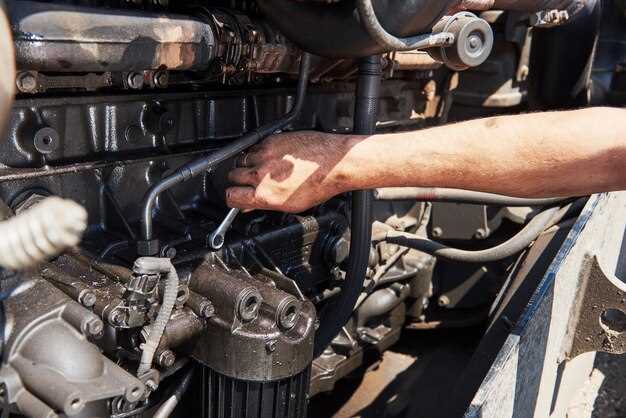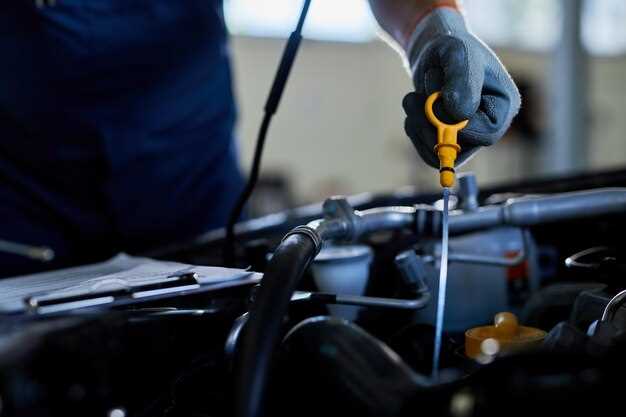How to Install an Oil Cooler for Better Engine Efficiency


The performance and longevity of an engine are significantly influenced by its operating temperatures. As engines work harder, they generate more heat, which can lead to a reduction in efficiency and ultimately cause damage. One effective method to combat this issue is through the installation of an oil cooler. By lowering the temperature of the engine oil, an oil cooler enhances performance and protects critical components.
Understanding the Benefits: An oil cooler serves to maintain optimal oil temperatures, ensuring that the lubricant remains effective in reducing friction and wear. High oil temperatures can degrade the oil’s properties, resulting in inadequate lubrication and increased engine wear. By installing an oil cooler, drivers can expect improved performance, increased horsepower, and extended engine life.
The Installation Process: Installing an oil cooler may seem daunting at first, but with the right tools and guidance, it becomes a manageable task. This article will provide a comprehensive overview of the installation process, highlighting essential steps, necessary tools, and common pitfalls to avoid. Whether you are a seasoned mechanic or a novice enthusiast, this guide will equip you with the knowledge needed to enhance your engine’s performance effectively.
Choosing the Right Oil Cooler for Your Engine Type
Selecting the appropriate oil cooler for your engine entails understanding your vehicle’s specifications and performance requirements. Different engine types, such as naturally aspirated, turbocharged, or supercharged engines, generate varying levels of heat during operation, necessitating specific cooling solutions.
For standard naturally aspirated engines, a basic oil cooler may suffice, typically consisting of a simple tube-and-fin design. These units effectively dissipate heat, ensuring optimal oil temperature even under moderate driving conditions.
In contrast, turbocharged and supercharged engines produce significantly more heat due to increased pressure and workload. For these engines, a more robust oil cooler, such as a stacked-plate design, is recommended. These coolers provide superior heat exchange efficiency and durability, handling the higher thermal demands imposed by forced induction systems.
Furthermore, consider the engine’s oil capacity. Heavier-duty oil coolers may be necessary for engines with larger oil volumes. This ensures that the entire oil system remains adequately cooled, preventing overheating during prolonged high-performance use.
The placement of the oil cooler is also critical. Mounting options include front-mounted or remote setups, impacting airflow and cooling efficiency. A front-mounted design typically benefits from increased airflow from the vehicle’s motion, while a remote option allows for more flexible installation and optimal positioning to minimize possible obstructions.
Lastly, compatibility with existing vehicle systems is paramount. Ensure that the chosen oil cooler is compatible with your engine’s oil type and capacity. Consulting with the manufacturer or a specialist can provide insights into the best options available for your specific engine type.
Essential Tools and Materials Needed for Installation
Installing an oil cooler is an effective way to enhance engine performance and longevity. To ensure a successful installation, having the right tools and materials is crucial. Below is a list of essential items you will need for the process.
Tools
- Socket Wrench Set: A variety of socket sizes will be necessary to remove and tighten bolts on the engine and oil cooler.
- Torque Wrench: For applying the correct amount of torque to hose fittings and brackets, ensuring a proper seal.
- Pipe Wrench: Useful for loosening or tightening hose fittings securely.
- Cuts and Band Tool: For cutting hoses to the appropriate length.
- Drill and Drill Bits: If mounting requires drilling new holes for the oil cooler brackets.
- Screwdrivers: Both flathead and Phillips head screwdrivers will be useful for securing components.
- Oil Filter Wrench: To remove the existing oil filter if it needs to be replaced during the installation process.
- Hose Clamps: Essential for securing hoses in place and preventing leaks.
Materials
- Oil Cooler Kit: A complete kit usually includes the cooler, hoses, and fittings tailored for specific vehicles.
- High-Temperature Oil Hose: Designed to withstand high pressure and temperature within the engine.
- Hose Fittings: Various sizes and types are needed to connect hoses to the oil cooler and engine.
- Mounting Brackets: To securely attach the cooler to a suitable location in the engine bay.
- Oil Sealant: To ensure that connections are leak-free, particularly at the fittings.
- New Oil Filter: It is advisable to replace the oil filter during installation to remove any contaminants.
- Synthetic or High-Performance Oil: Required for optimal engine performance post-installation.
- Consumables: Rags, gloves, and drainage containers for managing oil spills and maintenance of cleanliness.
Gathering these items before starting the installation will help streamline the process and minimize interruptions. Ensure all tools are in good condition to facilitate smooth installation and prevent damage to components.
Step-by-Step Guide to Removing the Stock Oil Filter
Removing the stock oil filter is a crucial step before installing an oil cooler. Follow this comprehensive guide to ensure a smooth process.
Before starting, gather the necessary tools and materials:
| Tools and Materials |
|---|
| Oil filter wrench |
| Drain pan |
| Rags or paper towels |
| New oil filter (if needed) |
| Engine oil (if required) |
Follow these steps to remove the stock oil filter:
- Prepare the Vehicle: Park the vehicle on a level surface. Turn off the engine and allow it to cool completely to avoid burns.
- Locate the Oil Filter: Identify the location of the oil filter. It’s typically situated near the engine block.
- Place Drain Pan: Position the drain pan underneath the oil filter to catch any oil that may spill during removal.
- Remove Oil Filter: Use the oil filter wrench to grip the stock filter securely. Turn it counterclockwise to loosen and remove it. Be cautious of the escaping oil.
- Inspect the Old Filter: Check the rubber O-ring on the old filter to ensure it came off with the filter. An O-ring stuck on the engine can cause leaks if a new filter is installed.
- Clean the Area: Wipe the surface where the filter was mounted with rags or paper towels to remove any oil residue.
- Check for Damage: Inspect the area for any signs of wear or damage. Address any issues before proceeding with the installation of the new filter.
After removing the stock oil filter, you are ready to install your new oil filter or an oil cooler, depending on your performance goals. Always follow the manufacturer’s instructions for the best results.
Proper Placement of the Oil Cooler for Maximum Airflow
Optimal placement of the oil cooler is essential to enhance engine performance and ensure engine longevity. The first consideration should be the proximity to the engine and the existing oil lines. Installing the cooler close to the engine reduces the length of the oil lines, minimizing potential pressure drops and heat loss.
Next, the orientation of the cooler itself plays a critical role in airflow. Positioning the cooler so that its core is facing forward allows for maximum exposure to the oncoming air. It is advisable to angle the cooler slightly downward, which assists in capturing air while minimizing the risk of debris accumulation.
Avoid placing the oil cooler in areas where airflow is obstructed. For instance, avoiding locations behind the radiator or in tight spaces can help maintain efficient airflow. Additionally, keeping the cooler away from heat sources, like the exhaust manifold, is vital to prevent elevated temperatures from impacting oil cooling efficiency.
For vehicles with a front-mounted oil cooler, consider installing a protective screen to prevent debris from clogging the cooler fins. Regular cleaning and maintenance should also be part of the installation plan to ensure sustained performance. Finally, testing the placement through airflow analysis can offer valuable insights into adjustments needed for improved efficiency.
Connecting the Oil Lines: Best Practices to Prevent Leaks

When installing an oil cooler, proper connection of the oil lines is crucial to ensure the system operates efficiently and to prevent leaks. The following best practices will guide you through the process.
First, always use high-quality hoses that are specifically designed for oil systems. These hoses should be resistant to heat and oil degradation, ensuring longevity and reliability. Consider using braided stainless steel hoses for added durability, as they offer superior resistance to abrasion and rupture.
Next, ensure that all fittings are compatible with the hoses you are using. Standardize the thread types and sizes to avoid mismatches. When connecting fittings, apply Teflon tape or thread sealant to the threads for a secure seal. Be cautious not to over-tighten, as this can cause damage to the threads and lead to leaks.
When routing the oil lines, avoid sharp bends and kinks, which can restrict oil flow and create stress points that may lead to leaks. Instead, maintain smooth curves and use appropriate clamps to secure the lines in position. Avoid excessive vibrations by strategically placing the oil cooler and ensuring lines are well-supported.
Once the oil lines are connected, it is essential to conduct a leak test. Tighten all connections then fill the system with oil. Start the engine and let it run for a short period, monitoring the connections for any signs of leaks. If any leaks are detected, shut down the engine immediately and address the issue before proceeding.
Finally, after the installation is complete, perform regular maintenance checks on the oil lines to ensure continued integrity. Inspect for signs of wear, cracking, or leaks and replace any compromised components promptly. Consistent maintenance will prolong the life of your oil cooler system and enhance engine performance.
Testing and Fine-Tuning Your Engine After Installation
After successfully installing an oil cooler, it’s crucial to ensure that your engine is performing optimally. The following steps outline the testing and fine-tuning process you should follow.
Initial Startup and Leak Check
- Before starting your engine, check all connections to ensure they are secure.
- Start the engine and let it idle while monitoring for any oil leaks around the cooler and connections.
- Keep an eye on the oil pressure gauge for any abnormal readings.
Engine Temperature Monitoring
After confirming there are no leaks, you’re ready to monitor engine temperatures.
- Allow the engine to reach operating temperature, checking the oil temperature using a gauge, if available.
- Compare the oil temperature to previous readings taken before the cooler installation, identifying reductions in temperature that indicate effective cooling.
Performance Testing
To assess the impact of the oil cooler on engine performance, conduct a series of tests:
- Acceleration Test: Measure the vehicle’s acceleration from a standstill to a specified speed. Note if there is an improvement in throttle response.
- High-Load Conditions: Simulate conditions that cause high engine stress, such as towing or climbing steep inclines, and observe how the temperature and power output of the engine are affected.
- Track Testing: If possible, take the vehicle on a track to test its performance under continuous high-stress conditions while monitoring engine temperatures.
Tuning Adjustments
Depending on the testing outcomes, you may need to fine-tune your engine settings:
- Adjust Air-Fuel Mixture: If the engine runs cooler and shows improved performance, consider optimizing the air-fuel mixture for better fuel efficiency and power.
- Recalibrate Ignition Timing: Ensure the ignition timing is appropriately set for the new performance metrics to maximize power output.
- Upgrade Engine Maps: If you have an ECU tune, modifications may be necessary to accommodate the improved thermal management.
Final Checks
Upon completing testing and adjustments, perform a final round of checks:
- Inspect all connections again for possible wear or fatigue from modifications and heat.
- Ensure your oil level is stable, as the new cooler may change the total oil capacity.
- Review any diagnostic codes if your vehicle is equipped with an onboard diagnostic system.
By following these testing and fine-tuning steps, you can maximize the benefits of your new oil cooler, ensuring your engine runs cooler and performs better.
